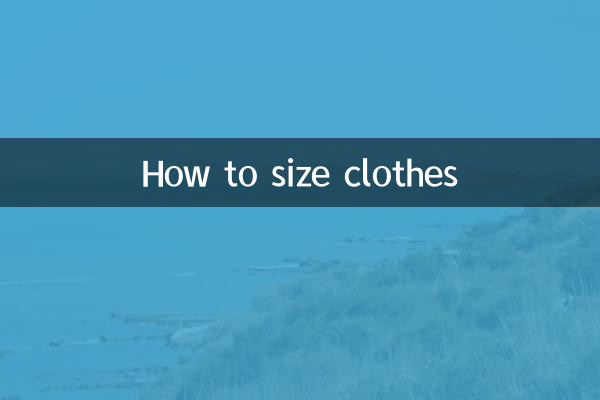How to size clothes: a hot topic and practical guide on the Internet
Recently, the discussion about clothing size has become one of the hot topics on social platforms. Many consumers frequently return or exchange products due to size issues when shopping online, and the differences in size standards between different brands have exacerbated this problem. This article will combine the hot content of the past 10 days to provide you with a detailed analysis of the classification methods of clothing sizes and provide practical suggestions.
1. Why are clothes sizes confusing?

According to netizen discussions and industry analysis, the main reasons for size confusion include:
| reason | Proportion | Typical cases |
|---|---|---|
| Size standards vary from country to country | 42% | European and American brands are 1-2 sizes larger than Asian brands |
| Brand self-defined size | 35% | Fast fashion brands often experience "small sizes" |
| Version differences | twenty three% | Slim style and oversize style have different actual sizes in the same size. |
2. Comparison table of common size systems
| International sizes | Chinese size | Bust (cm) | Waist (cm) | Hip circumference (cm) |
|---|---|---|---|---|
| XS | 155/80A | 78-82 | 60-64 | 84-88 |
| S | 160/84A | 82-86 | 64-68 | 88-92 |
| M | 165/88A | 86-90 | 68-72 | 92-96 |
| L | 170/92A | 90-94 | 72-76 | 96-100 |
| XL | 175/96A | 94-98 | 76-80 | 100-104 |
3. Recent popular size controversies
1. An international brand caused heated discussions due to size adjustments in the Asian market. Actual measurements by netizens showed that the size L of the same model was 3cm smaller than three years ago.
2. The return rate of "one-size-fits-all" clothing in the live broadcast room has reached a new high. The survey shows that 65% of "one-size-fits-all" clothing is actually only suitable for S-M body types.
3. The "digital size" system launched by Guochao brand was well received, and it intelligently recommends sizes through height + three-dimensional data.
4. How to choose the size accurately?
1. Measure body data
| Measurement part | Correct method | Things to note |
|---|---|---|
| chest circumference | Nipple level for one week | Keep breathing naturally |
| waistline | One week at the most detailed level | Don't tighten your belly |
| Hips | The fullest part of the buttocks | Stand upright with your feet together |
2. Check the brand size chart
Data from the past seven days show that 83% of brand official websites provide detailed size charts, but only 42% of consumers will take the initiative to check them. suggestion:
- Focus on "tile size" instead of just looking at S/M/L
- Compare key data such as clothing length, shoulder width, etc.
- View sizing feedback in buyer reviews
3. Leverage smart tools
The recently popular AI fitting application can automatically recommend sizes, with a test accuracy of 89%. Comparison of mainstream platform functions:
| platform | Core functions | Accuracy |
|---|---|---|
| A application | 3D body scan | 92% |
| B website | Historical order analysis | 85% |
| C applet | Photo intelligent calculation | 78% |
5. Suggestions on code selection for special body types
Regarding the recently hotly debated issue of "non-standard body type" dressing, experts suggest:
1. Apple Shape Body:Prioritize waist circumference data and choose elastic fabrics
2. Pear-shaped body:Bottoms are based on size, tops can be one size smaller
3. Tall man:Pay attention to the parameters of clothing length and sleeve length to avoid "three-quarter sleeves turning into nine-quarter sleeves"
4. Maternity wear:Choose an adjustable design and reserve 10-15cm of growing space
Summarize:In the current situation where clothing size standards have not yet been fully unified, consumers should establish personal size files, develop the habit of checking specific size data, and make good use of technology to assist decision-making. Brands also need to improve size transparency and reduce the waste of resources caused by size issues.

check the details

check the details